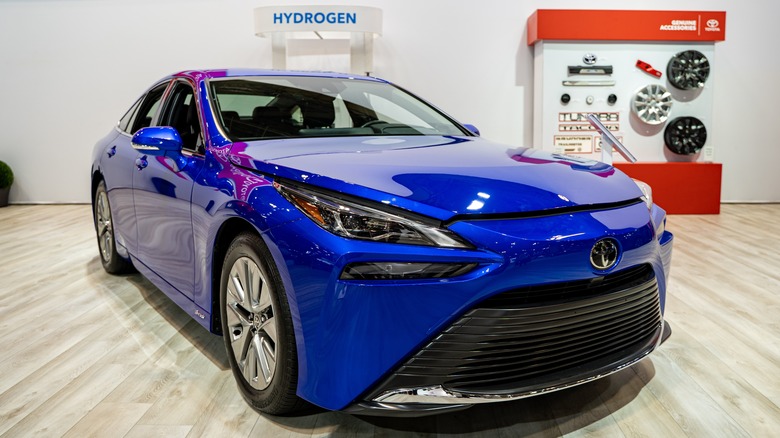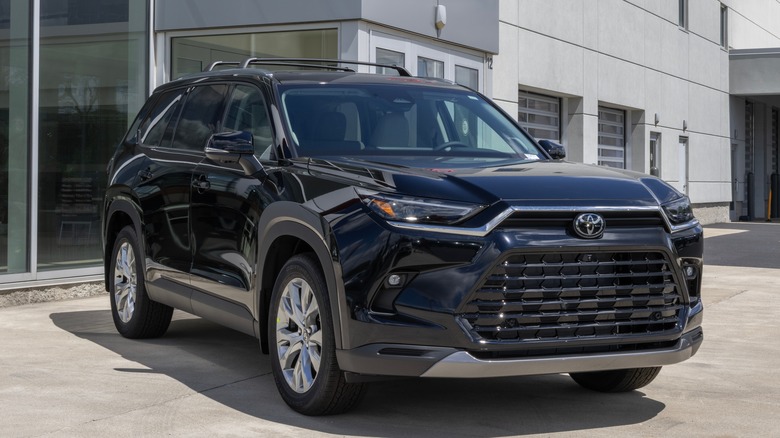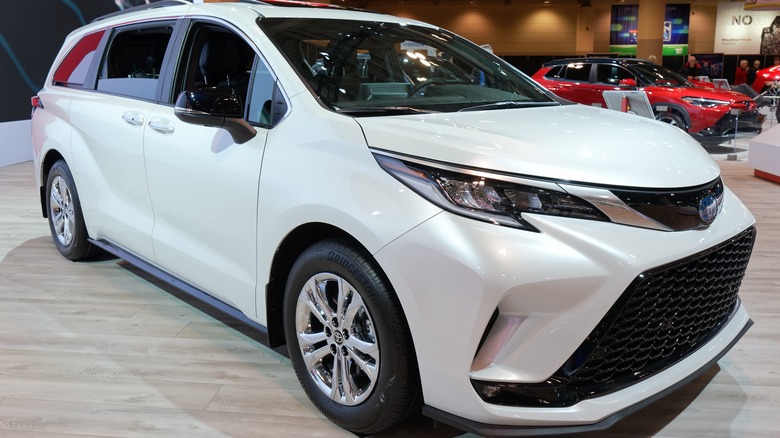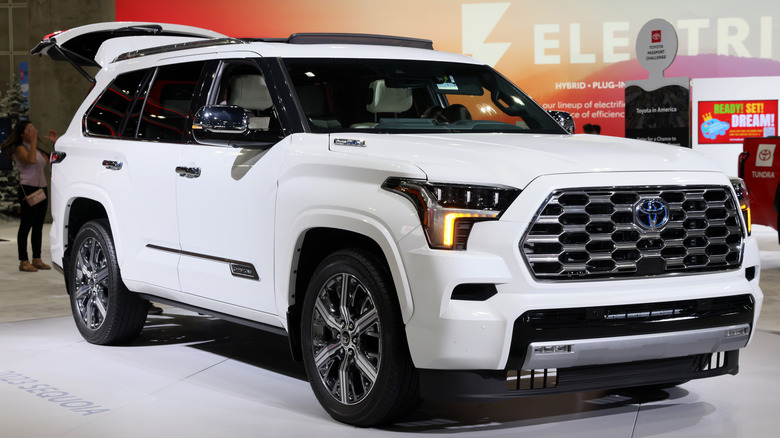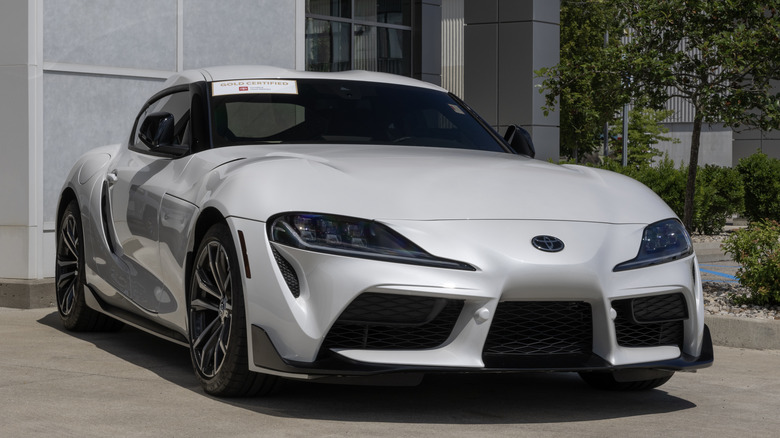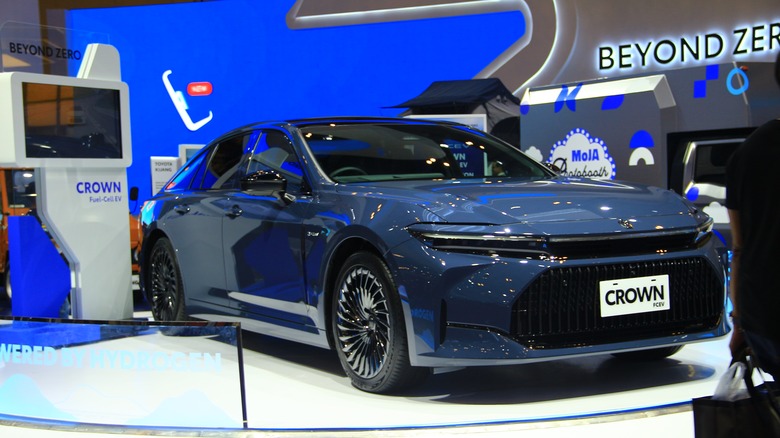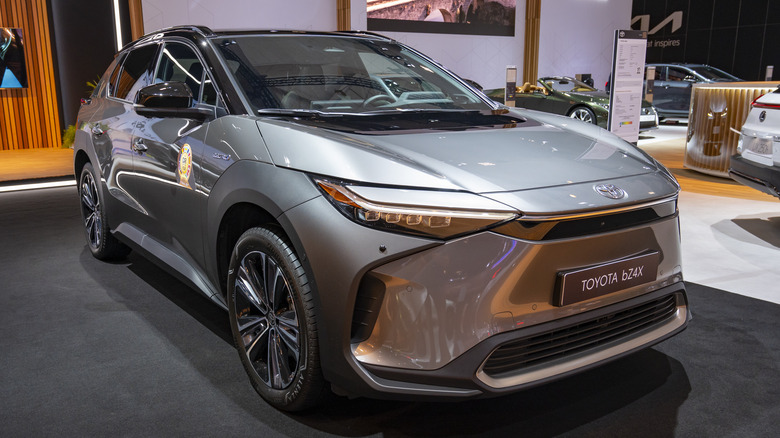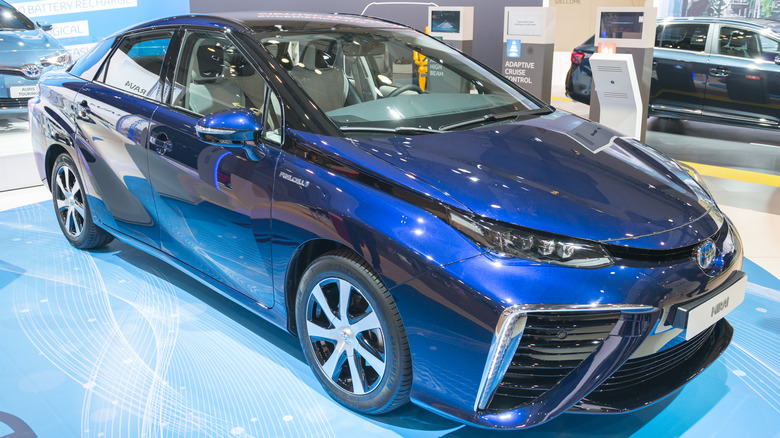You've Been Warned: These 9 Toyota Cars Have Awful Resale Value
Toyota cars are deemed a "safe" bet — an automotive blue chip. Drivers trust them because they are tough and high quality. On its 2025 list, Consumer Reports ranked Toyota #13 out of 27 in terms of road tests, new and used car reliability, maintenance, and owner satisfaction. But car ranking is a roller coaster. For instance, Toyota and Lexus lost first place (and lowered to 3rd) to Subaru in the CR 2024 reliability report. Anyhow, Toyota is a respectable automaker as a whole. On the used market, the Japanese brand boasts models with exceptional five-year resale value, including the indestructible Tacoma and the Tundra, both refusing to shed value, all the way to the Corolla Hatchback.
On the whole, Toyota is one of the very best brands for avoiding the financial sting of depreciation, with many people associating the brand with outstanding resale value. This reality, however, doesn't apply across the entire lineup. A few models have slipped into a kind of black hole because of their high depreciation only five years after rolling off the lot and earned a literal "awful" grade. Today, to save you some browsing time, we've dug through the data to find nine Toyotas that, for one reason or another, skipped the value retention class. Having this information is especially handy if you've already decided to sell or trade in your Toyota for a newer, more modern model. This is not an attack on the brand; rather, it's a guide for savvy buyers.
Grand Highlander
The Highlander is a money-maker for Toyota; the "default" answer for millions of families. It can fit seven people with second-row captain's chairs or eight passengers with a second-row bench seat. A big SUV indeed. But its resale value is somewhat inconsistent because of a "tale of two Highlanders." This is a story of "brand dilution," where an emerging, unproven model threatens to tarnish the gold-plated reputation of the original. First, the regular Highlander is a depreciation-fighting champion. CarEdge estimates a 40% 5-year loss — not that bad — and ranks it in the "top 20 models" for value at the 3, 5, and 7-year marks. Kelley Blue Book gives a thumbs up, stating a 2023 model's 14% 2-year loss puts it in the "top 10-25%" for devaluation among all 2023 SUVs. So, why is it on this "awful" list?
Enter the Grand Highlander, a new, larger, more expensive version that the market doesn't have much faith in. This latest version may lose over half of its original price in five years. This seems to mirror the Sequoia's situation: the dreadful label targets not the Highlander you know, but the untested and potentially flawed Grand Highlander. By launching a predictably high-depreciation model under the "Highlander" banner, Toyota is risking the brand equity of the original. It's not a Nostradamus prophecy, of course, as it might stabilize in the future, but so far, this is the projection. The Grand's poor value forecast weakens the name, as consumers searching for a used Highlander will now be faced with two very different residual worth curves.
Sienna
Without a doubt, this entry might sound like the most ridiculous on this list. But it's a perfect example of "awful-for-a-Toyota." The Sienna, the brand's only minivan, is being singled out here because, according to SlashGear, it is "slated to lose anywhere from 38% to 41% of its worth after five years." But a 41% loss on a $40,000 family hauler doesn't hit too hard, does it? Zooming out, a 41% loss (or a 59% residual value) sounds depressing only when you compare it with a Tacoma, Tundra, Corolla, or other Toyota vehicles. That's why it secures a place here. Because of its minivan nature, the Sienna's depreciation curve wavers over time. For instance, Kelley Blue Book shows the 2018 model losing a hefty chunk of its worth in its first three years, while the 2020 sheds it more slowly over that same window. For CarEdge, the Toyota Sienna behaves well in the aftermarket, holding a decent 62.4% of its original MSRP and shedding 37.6% over a five-year period.
When you compare the Sienna with its actual competitors, the Honda Odyssey, the Kia Carnival MPV, or the Chrysler Pacifica, for example, the Sienna isn't just good. You'll find it's the undisputed and defending champion of minivan worth. Apart from mileage and years of use, the Sienna's value plummets because it also lives in a chaotic world of children's weekends, daily school runs, and football practices — a recipe for wear and tear. And that kind of use speeds up the vehicle's depreciation the moment you buy it. In short, that 41% loss (SlashGear) or 37.6% (CarEdge) is indeed a triumph. Of course, it's "awful" for a Toyota but miraculous for a minivan.
Sequoia
The old second-generation Toyota Sequoia V8 (2008-2017) stood as an invincible body-on-frame tank. For sure it looked ancient and like a gentle giant, but it held its value forever because of its bulletproof reputation. What about the new third generation, launched for 2023? The market is... well, not impressed. We can say it's a platform-sharing compromise example. On devaluation, the data is split, which signals market fuzziness. On the one hand, CarEdge has a respectable estimate of 37% depreciation after five years. SlashGear, more pessimistic, forecasts up to a 55% loss. This is an alarming figure for a vehicle that, in 2025, starts at $62,425 for the basic SR5 version and runs up to $83,915 for the Capstone trim. But this drop appears to hit only newer models, as the 2008-era Sequoia still retains between 69% and 71% of its worth after half a decade, per KBB.
You might be wondering about the pessimism for the new model. In part because of a brutal comment from Consumer Reports that the car was "outdated on arrival." CR's review notes that while it has a burly, high-tech hybrid powertrain, it feels quite old-school. But Toyota's cardinal sin in the Sequoia is the placement of the modern hybrid battery, which significantly shrinks cargo space. Let's be clear. The whole point of buying a giant three-row SUV is to haul people and their stuff, but the Sequoia fell short in the "stuff" department. It'd be fine to tuck the hybrid system in a truck bed, but in an SUV? It really devours the cargo floor. It's like switching from gasoline to "autogas" (LPG) power and then sacrificing the entire trunk to the cylinder, leaving room for nothing but regrets.
Venza
Here's another "awful-for-a-Toyota" example. CarBuzz points out that the Venza retains value so well that it somehow landed on the site's 2024 "10 Cars With Best Resale Value" list. Yes, but at number 10. In other words, the Venza was the worst car on the best list. With figures, CarBuzz notes a respectable 3-year depreciation of 23.5%. Objectively good. However, longer-term projections paint a somewhat gloomier forecast. Both iSeeCars and CarEdge project a 38% drop in five years. On a $42,899 vehicle, it's a $16,130 hit. Not terrible either, until you compare it to its super successful, more popular, and less expensive sibling, the RAV4 Hybrid, which keeps an almost unbelievable 70% of its worth after 60 months. We can say the Venza is a victim of "product cannibalization," much like when Apple killed the iPod with the iPhone in 2007.
Despite the Venza being the "style" choice, offering a sleeker roofline in exchange for less cargo space and a higher price, on the new car lot, buyers overwhelmingly chose the RAV4 — more spacious and practical. And this showroom battle led the Japanese carmaker to discontinue the Venza after the 2024 model year. It was replaced by the Crown Signia, a more upscale and modern hybrid option. Will this new crossover hold up in terms of resale value? Only time, and customers, will tell. Venza's fall from grace has created an opportunity for people on the lookout for good prices. It's stylish, reliable, and efficient, making it a prime contender for the best bargain cars on the used market.
Avalon
At the 1994 Chicago Auto Show, the Avalon made its debut as a replacement for the Cressida, featuring a 3.0-liter V6 engine and built on a stretched Camry platform. In its fourth generation, it was fully redesigned and entered the hybrid market with a 2.5-liter four-cylinder and an electric motor. The Avalon was not a bad sedan, au contraire. In both its gasoline and hybrid versions, it stood as a fantastic vehicle — big, comfortable, reliable. An ideal choice for a quiet, long-haul cruiser. Looking at the historical data, you'll see its strong value performance. KBB figures for the 2022 edition, for instance, show total depreciation of only about 25% over 3 years. A solid number, actually. So, how come it landed on this "awful" list? Because it was discontinued after the 2022 model year.
Now, it's a dead "zombie" car. Toyota said it retired the Avalon because buyers preferred crossovers and SUVs over large sedans. And what replaced the Avalon? The Toyota Crown — something like a sedan — which, as you'll read below, is projected to have a disastrous future value. Perhaps that wasn't Toyota's shrewdest move. In the automotive world, the Avalon is under a discontinuation curse. When a car line is orphaned (meaning no new models), its resale value has no option but to drop. For sure, the Avalon's worth isn't that terrible at the moment, but it's a ticking clock before the value takes a nosedive. Also, as the car ages, parts will eventually become scarcer. If you own one, you might want to sell it while the market's hot. The Avalon is a fading asset; a ghost in the Toyota lineup.
GR Supra
Is the Toyota GR Supra a rock-solid investment that withstands the shocks of depreciation or rather a financial pitfall wrapped in a legendary name? We've got to analyze the data first. To start with, this car might suffer from a rolling identity crisis. On the outside, a Toyota JDM (Japanese Domestic Market) made in Austria, but on the inside, a BMW Z4. And its residual value is just as muddled, creating a full-blown clash of data in the market. Look at these figures. SlashGear lists it as having a terrible resale price, projecting a modern Supra to lose anywhere from 38% to 45% of its original cost in five years. On a $60,000 car, that's a potential loss of over $20,000. On the other hand, CarEdge says it has a good value, estimating only 23% depreciation after half a decade, with a $59,354 vehicle retaining $45,667.
CarBuzz goes even further, claiming the Supra refuses to depreciate, and cites Kelley Blue Book data showing a 2020 model (original MSRP $50,985) with a 2025 Fair Market Value of $47,374 — a loss of only 7% in five years. And even noting a pre-owned one sold at auction for more than its original MSRP. This wildly optimistic 7% loss is a snapshot of the insane post-pandemic used car bubble, a time of historic shortages where all desirable sports cars were in high demand. CarEdge's 23% and SlashGear's 45%, more sober calculations, are forecasting a return to a normal market. The GR Supra is on this list because of that 38-45% loss, which is the most likely long-term reality.
Crown
It's new. It's expensive. And it's weird. The Toyota Crown is the substitute for the dearly ditched Avalon; but it's not a sedan. It's also not a crossover. It's a lifted sedan, a high-riding vehicle that seems to be a solution to a problem nobody, anywhere, has ever had. No worries, the market also scratches its head right along with you. And that discombobulation is being reflected in its value, which is falling faster than its high-riding stance. According to CarEdge, the Toyota Crown is expected to depreciate by 51% after five years. For a selling price of $50,722, that leaves a resale price of only $24,828 after 60 months. So, let someone else take that initial $25k depreciation bath. iSeeCars, in this case being more positive, projects a 43.6% loss. Not much of a difference.
Either way you slice it, this premium vehicle is losing close to half its sticker price. Toyota devised the Crown to solve the "people don't buy sedans anymore" problem by, well, making a sedan that's also sort of a "short" SUV. But in doing so, the Crown ends up with no clear buyers. We don't know who this vehicle is for. It is not as practical or spacious as a Highlander (a real SUV), and in no way as sleek or established as a Lexus ES (a genuine luxury sedan). The worst part is that for $50,000, drivers can get either of those. The Crown stands as a shining example of cars you should only buy used to save money. Projections haven't been kind to the Crown; neither have they been nice to the Wagoneer, a popular Jeep with a terrible resale value, which, like the Crown, keeps only around 50%, or less, of its worth after half a decade.
bZ4X
At the 2021 Los Angeles Auto Show, Toyota unveiled the bZ4X, promising an estimated range of 250 miles (for the FWD trim) in the brand's first BEV (battery electric vehicle) of the "bZ (beyond Zero)" series. The vision was to shift from hybrid to fully electric. To begin with, the name, which sounds like a Wi-Fi password, should have been the first warning sign. While Toyota perfected the hybrid and has made huge strides in this field, this initial mass-market foray into the all-electric world has been a critical misfire. And the used market is punishing it severely — the depreciation is brutal. CarEdge forecasts the bZ4X will depreciate 58% after 5 years. Meaning, a car purchased for $42,713 will have a resale value of only $17,794. Not just that.
Short-term data from InsideEVs reports that one 2023 bZ4X Limited, priced at $50,130 new, was listed for sale at $32,673 after a measly 5,000 miles and eight months in service. Holy depreciation! That's a 34.8% drop in under a year. The reason, as InsideEVs states, is because of its poor range and slower charging capabilities at a price that is insanely unattractive. Also, a real-life test of a 2023 model showed it only reached a top charge rate of 88 kilowatts, requiring over four hours to hit 99% power. In a world of fast, long-range Teslas and Kias that can recharge in 20-30 minutes and easily top 250 miles between plug-ins, the bZ4X ends up looking rather absurd. To add insult to injury, Toyota's own plug-in hybrid, the RAV4 Prime, holds its value exceptionally well (losing only 17.7% in two years), making the bZ4X's 35% eight-month fall look even more pathetic.
Mirai
A failed science experiment, the Mirai ranks as the worst on this list. The figures are so bad they look like typos. CarEdge says the Toyota Mirai is expected to depreciate a mind-numbing 84% after 5 years. Yes. Let that sink in. A new retail price of $64,019 would have a resale value of just $9,981 after 60 months. But you needn't wait that long. CarBuzz reports that some Mirai have lost a staggering 65% of their worth in only one year, noting that 2021 models, with an MSRP of $49,500, can already be found on the used market for less than $10,000. Even 2024 versions, starting over $50,000, are reportedly selling for between $15,000 and $18,000. Why is this car hemorrhaging value? As SlashGear puts it, it's a hydrogen fuel-cell vehicle (FCEV), and the world has "pretty much decided" that this isn't the future of green motoring.
Besides, it offers no real benefits over a battery electric vehicle (EV), and the hydrogen fueling network is, to be blunt, a joke. There are around 54 retail hydrogen-fueling stations in the U.S., most of them in California, and building a new one costs over $2 million. While the number of EV charging points is estimated at about 76,000, with over 228,000 plug-in ports as of September 2025. The only person who should own a Mirai is the second, or third owner, who can snag a $64,000 luxury sedan for $10,000 and also happens to live next door to one of the few hydrogen stations in existence.
